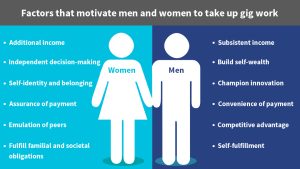Same problems, same inequalities: Women in the digital gig economy
by Nancy Kiarie, Anup Singh and Edward Obiko
Mar 11, 2020
5 min
The digital gig economy in Africa has quickly gained prominence over time and continues to enhance opportunities for youth and women. Some of MSC’s recent research work in Kenya indicates increasing participation of women, especially in the blue-collar digital gig economy though there remains a gender disparity in women’s participation in this sector.
“Gig work provides the flexibility I need but not the money I deserve…”
The world is increasingly going digital and technology that could only be imagined a decade ago is now a reality. Innovation has had a significant impact in encouraging women’s participation in the delivery of services enabled by technology platforms. This has given rise to the gig economy—an ecosystem that facilitates workers who are either employed or unemployed to earn income through part-time jobs, referred to as “gigs”.
The digital gig economy in Africa has quickly gained prominence over time, and continues to enhance opportunities for youth and women. Research ICT Africa estimates that by the end of 2018, there were 277 unique digital platforms in Africa alone serving close to 5 million gig workers. Some digital platforms operate internationally, such as Airbnb, Uber, Jumia, which serve multiple markets. Others are more localized and target their own markets, such as Sendy and Lynk in Kenya, goDropping in Ghana, and Gokada in Nigeria, among others.
Gender dynamics in the gig economy
Some of MSC’s recent research work in Kenya indicates increasing participation of women, especially in the blue-collar digital gig economy. Emerging platforms are enabling women to take up gig work and use their time more effectively. The flexibility of gig work enables women to offer services they are skilled at and schedule their work according to their availability. However, we observed that women were more involved in traditionally female-oriented jobs, such as hair-dressing, beauty, and housekeeping. Women take on these roles because of their familiarity in that line of work, their risk-averse nature, as well as the dictates of societal norms. Men in the gig economy are more involved in jobs such as delivery, construction, driving, and home repairs.
A behavioral analysis of gig workers reveals significant differences between the motivations for women becoming gig workers as opposed to men.
This nature arguably—and inequitably—predisposes men to navigate gig work on digital platforms in a more lucrative manner. We have examined some of the reasons for the gender gap and would like to propose some measures to overcome the discrepancy.
Women face unique challenges when they use digital gig platforms to source work and market their products and services. In many emerging economies, ownership of digital devices that enable access to gig platforms has historically been uneven between men and women. Gig platforms in Kenya, such as Littlecab, a ride-hailing service or Sendy, an errands company, demand 24-hour availability to offer services. Women’s availability on digital gig platforms that require physical presence is restricted due to domestic demands. The number of hours that workers log on most platforms informs their ratings. This, in turn, affects their presumed relative level of capability negatively. Consequently, women get less gigs on platforms that assign job opportunities based on user ratings, which are influenced by platform experience.
Female gig workers and customers alike also face increased security risks in gig work that require their physical presence. For example, female customers express higher security concerns when hailing taxis on digital platforms. Female workers report instances of sexual harassment and thus are less willing to serve male customers, especially at odd hours of the day. In an interview with a female worker who offers beauty and wellness services, she indicated that “unwarranted demands” from men had driven her to avoid work requests from male customers.
As in the workplace, women on these platforms struggle to earn equitably. Women are observed to be more flexible in pricing and are more susceptible to being underpaid on gig platforms—including white-collar gig work. This sometimes goes to the extent of not covering the costs they incur to deliver the services. Consequently, women gig workers who charge prices commensurate with men for their services often get less business on digital platforms. A system where women charge less than their male counterparts leads to a devaluation of the services they offer.
Even as they deal with these challenges, female platform workers either do not get sufficient work or drop out entirely from the digital gig platforms.
How can we encourage women to participate in the gig economy?
Stakeholders can explore different measures to address these challenges and encourage the continued participation of women. Some platform owners have been proactive in putting in place measures to resolve these issues.
To account for the intermittent availability of female workers, a system that allows workers to indicate when they are available could limit the negative implications that arise out of the level of platform experience of female workers. This way, the platform would not automatically discriminate women on ratings when they are not available.
Some platform owners provide an option for users and workers to choose whom they would like to receive services from or serve. For example, Bolt, a taxi-hailing app in several countries in Africa, allows female customers to choose female drivers and vice versa. AnNisa is a women-focused taxi-hailing platform that is run by women and serves women exclusively.
Some platform owners have implemented standard pricing for specific services to ensure the workers get adequate pay for their work. Platform owners could also put in place algorithms that encourage uniform pricing and let users simply choose a gig worker based on their respective ratings. Alternatively, gig platforms should explore measures through which customers can provide quality of service reviews that are used to rate workers on the platform. Higher ratings should allow workers to justify higher pricing, rather than ascribe to standard platform pricing.
Women’s empowerment through increased participation in the gig economy
Participation of women in the digital gig economy not only enhances employment opportunities and provides a source of income; it also helps to create a digital footprint of their work, and financial records in several instances. This, in turn, provides necessary data that financial institutions could use to design the right products and services to enhance women’s financial management and risk mitigation. When women are financially independent, it enhances their decision-making power, which boosts women’s economic empowerment.
We have a way to go to harness the gig economy for good.
 by
by  Mar 11, 2020
Mar 11, 2020 5 min
5 min




Leave comments